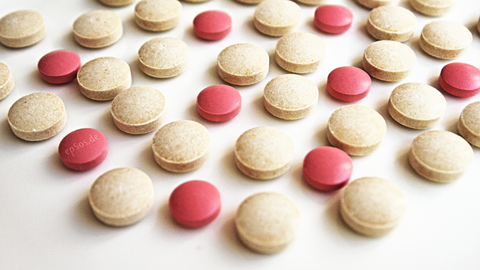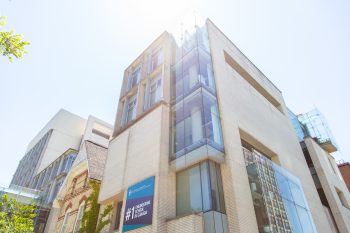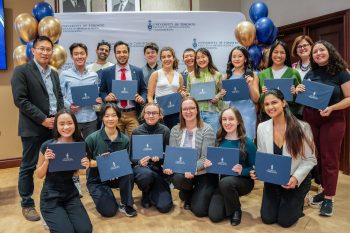As he rotates his palm upwards and wiggles his fingers slowly, Martin Labrecque’s hands take him down the dark alley of a video game. One finger flicks two zombies into oblivion, another heals a teammate – all without cumbersome controllers.
Welcome to the ExoGlove, an early-stage invention from U of T Engineering alumnus Martin Labrecque (CompE MASc 0T5, PhD 1T1). The prototype uses a “glove” of sensors that could soon help surgeons, video editors, gamers and those with diminished motor skills interact more intuitively with technology.
The ExoGlove is one of five projects that recently received Heffernan Commercialization Fellowships, a program that awards promising inventors with $32,000 to develop their products into viable businesses.
The fellowships are part of a $5 million gift to the Faculty from U of T Engineering alumnus Gerald Heffernan (MMS 4T3), and they continue to enable graduate students to transfer their research into new Canadian technology companies.
Past recipients have included James Dou (ECE MASc 1T6), whose disease-detecting biomedical devices led to founding the company ChipCare; and Carlos de Oliveira (CivE MASc 0T6), who worked alongside Professor Constantin Christopoulos (CivE) to develop earthquake-resistant structural casting, founding Cast ConneX.
Take a closer look at this year’s five projects receiving Heffernan Commercialization Fellowships:
ExoGlove
Martin Labrecque (CompE MASc 0T5, PhD 1T1)
A promotional video from Breq Labs Inc. highlights the many uses of ExoGlove.
With ExoGlove, a doctor can interact with a computer screen in the middle of surgery or an elderly person could answer a call by holding her hand in the phone symbol. The device allows users to control a computer simply by moving their hand.
Despite its name, Labrecque’s invention is not an actual glove. It’s a clip-on wireless attachment consisting of five rings – one for each finger – connected by wires that fasten around the wrist. It does not interfere with the palm of the hand, so it can be used easily in combination with other tools.
Because it does not use cameras to track movement, the ExoGlove has no line-of-sight issues like other motion-tracking tools currently in development. It can be used with any level of light, and with any USB-compatible device.
“Working on other people’s start-ups taught me a lot about what works and what doesn’t,” said Labrecque. “I think business knowledge is very important. Equally valuable, though, is being able to connect with people who are good in the areas where you lack.”
Labrecque hopes to have ExoGlove in mass production and on the market within the year. Gamers are his initial target, but secondary markets include those with accessibility issues, rehabilitation, 3D rendering, video editing artists and much more.
A new catalyst for carbon-carbon bonds
Adam McKinty (Chemistry PhD 2013)

Forming carbon-carbon bonds – best understood as chemical reactions that join carbon atoms together – is important to the manufacturing process in many industries, including pharmaceuticals, cosmetics, plastics and more. Forming these bonds can make bulletproof plastics, and even turn canola oil into diesel fuel.
Despite their wide application, there are few technologies available capable of catalyzing – or creating – these valuable bonds, with one of the major methods controlled through a single company’s monopoly.
Adam McKinty (Chemistry PhD 2013) has developed a new method to perform virtually the same bonding reactions as this monopoly company, and at a low cost – called olefin metathesis – in partnership with his advisor Professor Douglas Stephan (Chemistry).
Their technology has already demonstrated success in a number of uses, and the next step is using the powerful method across a wide variety of applications in order to showcase its impact to potential buyers.
Commercializing a new organic electronic material
Andrew Paton (ChemE PhD 1T3)

Many of our modern solar cells and LEDs – which use non-organic semi-conductors made from silicon – are becoming less desirable for use in the next generation of technology. They require high processing temperatures and return on investment can take up to 30 years.
In Professor Tim Bender’s (ChemE) lab, Andrew Paton (ChemE Phd 1T3) and colleagues are developing organic semi-conductors with fewer materials, making them smaller and more cost effective for tomorrow’s electronics. Made out of organic components, they also have high conductivity and light absorption, properties which allow for thinner and more flexible television screens and monitors.
Paton is exploring several commercialization streams for his product, including organic light-emitting diode (OLED) and organic solar cell (OSC) manufacturers.
Novel ways to communicate with patients in an MRI
Garry Liu (MedBio PhD 1T3)

Being inside a magnetic resonance (MR) imaging suite can be an intimidating experience for many. The small space is uncomfortable, and the noisy operation of the scanner makes intercoms ineffective. To allow for audio communication, wireless headsets initially appear appropriate, especially due to the clinician’s limited mobility within the suite. However, an electromagnetic shield around the scanner room, called the “Faraday Box,” makes this particularly difficult.
Thinking outside that box, Garry Liu (MedBio PhD 1T3) proposed a wireless communication headset that is magnetic-resonance safe and does not interfere with the MRI’s functionality. This reduces stress for the patient, while increasing efficiency for the technician.
Interventional procedures inside a MR imaging suite are becoming more common. Many therapies turn to MR imaging to provide soft-tissue visualization without the damaging effects of radiation. In such a rapidly growing field, Liu’s mentor, Graham Wright (IBBME) sees a great deal of potential in the product.
Liu seeks to incorporate his technology in all local interventional-MRI sites, such as Sunnybrook Health Sciences Centre and the Princess Margaret Hospital. He will approach them with demonstrations of early-adopter material and, through the niche research network, continue to market the technology at tradeshows and events.
Improving drug screening using microfluidics
Oleg Chebotarev (MechE MASc 1T2)

Testing and releasing a new drug can cost the pharmaceutical industry up to $1 billion – with only one in approximately 10,000 drugs ever reaching market. Often, this time and money is wasted due to poor drug testing platforms that don’t reflect the environment in which the drug will be administered: the human body.
That’s why Oleg Chebotarev (MechE MASc 1T2) developed a new platform for drug screening – one that closely resembles the conditions of common drug target organ tissues (brain, liver, vasculature, etc.). This commercially viable system has seen remarkable results, and enables early stage drug discovery because of its similarity to human physiology.
Chebotarev plans on marketing his technology to pharmaceutical and therapeutic biotechnology industries. He’s already piqued the interest of several companies, and continues to develop both the technical and business sides of his enterprise.
The Heffernan Commercialization Fellowships encourage development of Canadian technology-based start-ups by asking professors to nominate students and their promising ideas. The professors then mentor the students through the process of development, availing them of expertise, resources and feedback.
Read more about this year’s fellowship opportunities, as well as on Gerald Heffernan and his significant contribution to the forthcoming Centre for Engineering Innovation & Entrepreneurship.



